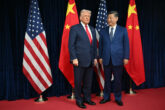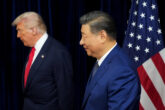May 21, 2025
Regional and Global Responses to a Taiwan Contingency
Gauging the Prospects for Coalition-Building Under Fire
Executive Summary
A contingency across the Taiwan Strait has the potential to reshape the Indo-Pacific and even global security environment. This report explores how states beyond the United States and Taiwan would respond to a major Taiwan contingency. It defines a major Taiwan contingency as a conflict that might start in the so-called gray zone between peace and war but clearly escalates into a larger campaign that has unification as the near-term objective of the People’s Republic of China (PRC). Specifically, the report examines how geopolitical interests, values, and material power might determine the approaches of countries across the region and the world.
Regional and global responses to a major Taiwan contingency would depend heavily on structural factors present at the time it happens, as well as the specific circumstances of the situation. The report details four key structural factors that would shape states’ responses: the specific nature of the Taiwan contingency, the global trade and technology landscape when the contingency occurs, Taiwanese and U.S. capabilities and responses, and the spectrum of intervention options.
Beyond those structural factors, the response from four groups of states would play a major role in determining the outcome of a major Taiwan contingency. The first group is Japan and the Philippines. Both U.S. allies would be on the front lines of a Taiwan conflict and host U.S. forces but are also the most exposed to military retaliation from China. The second group is close U.S. allies and partners South Korea, Australia, and India. Their locations are farther from the main battlespace, but each would have to consider how its response would affect its own security concerns and relations with the United States in the future.
Regional and global responses to a major Taiwan contingency would depend heavily on structural factors present at the time it happens, as well as the specific circumstances of the situation.
The third group includes the other states in Southeast Asia. Thailand and Singapore would have to consider their defense ties to Washington, while Cambodia, Laos, and Myanmar might get requests from Beijing. Other Southeast Asian states would adopt a studiously neutral stance. The fourth group is Europe and the rest of the world. European states now pay more attention to Taiwan, and many see parallels with Ukraine’s plight. But uneven ties with China and a lack of power projection capabilities would mostly limit direct European intervention. Meanwhile, the developing world would likely side with Beijing. And it lacks the political will—much less the proximity or military power—to come to Taipei’s aid.
Several findings flow from the analysis: First, it is unlikely that any other states will come to Taiwan’s aid if Taiwan does not fight fiercely and the United States does not intervene on a large scale. Second, geographic proximity increases a country’s stake in the defense of Taiwan, but that same closeness also makes countries more vulnerable to PRC retaliation. Third, any Taiwan contingency would cause massive economic harm, so states would try to balance protecting their economic interests—especially access to high-end semiconductors—with ending the conflict just to stem the disruption caused by the fighting. Fourth, states’ choices will reflect their national interests and values, but those responses will depend to a significant degree on what others do.
U.S. policymakers should take the following actions to best position Washington to mount an effective coalition defense of Taiwan during a contingency, should those policymakers choose to do so:
- Prioritize preventing a Taiwan contingency.
- Reinforce with Taipei how much would hinge on Taiwan’s contingency response, both in terms of demonstrating will and capabilities.
- Expect limited contributions but be creative in exploring what in the spectrum of intervention might be possible.
- Deepen intra-Asian and Euro-Asian security ties that include the United States.
- Support and, where possible, facilitate the growth of intra-Asian security ties that do not rely on the United States as the hub.
- Plan for humanitarian evacuation operations as a means to encourage Southeast Asian countries to think through a Taiwan contingency.
Introduction
A contingency across the Taiwan Strait has the potential to reshape the Indo-Pacific and even global security environment. That possibility has prompted numerous analyses of how Taiwan (officially, the Republic of China or ROC) and the United States might respond to aggression from China (officially, the People’s Republic of China or PRC). The ways other states in the Indo- Pacific region and beyond might respond, however, have received considerably less attention and would be a critical factor shaping any cross-Strait contingency.
This report explores how those other states might respond to a Taiwan contingency.1 Specifically, it examines how geopolitical interests, values, and material power might determine the approaches of countries across the region and the world. This analysis employs an approach with three defining characteristics. First, it charts a middle path between two analytic extremes: either saying “it depends” due to the myriad variables that would influence Taiwan contingency responses, or the false certainty of offering highly detailed forecasts based on just one possible scenario. Second, the report is deliberately concise, highlighting only the central actors and the critical factors shaping their behavior. Third, the text focuses on what the authors call a major Taiwan contingency, meaning a conflict that might start in the so-called gray zone between peace and war but clearly escalates into a larger campaign that has unification as Beijing’s near-term objective.2
The report proceeds as follows. It starts by exploring key structural factors that would shape states’ responses to Taiwan contingencies. Next, it examines the contours and determinants of how four key groups of states might respond to a Taiwan contingency. The four groups are the geographic frontline states of Japan and the Philippines; close U.S. allies and partners South Korea (officially, the Republic of Korea or ROK), Australia, and India; Southeast Asian states (other than the Philippines); and the rest of the world, including Europe and the developing world. The report concludes by detailing findings and recommendations for policymakers in Washington as well as like-minded capitals.
Download the Full Report
- This report assumes U.S. policy as its baseline and therefore does not recognize Taiwan as an independent state or advocate that Washington do so. No grammatical or syntactical construction in this paper should be construed as asserting or suggesting otherwise. ↩
- Jacob Stokes, Resisting China’s Gray Zone Military Pressure on Taiwan (Center for a New American Security, December 7, 2023), 1–14, https://www.cnas.org/publications/reports/resisting-chinas-gray-zone-military-pressure-on-taiwan ↩
More from CNAS
-
Chinese Maker of Bitcoin-Mining Machines Is a Security Threat, Says Expert
Bloomberg News reports that a Chinese manufacturer, Bitmain Technologies Ltd, that sells most of the world’s Bitcoin-mining machines — including 16,000 of them to a venture ba...
By David Feith
-
Indo-Pacific Security / Energy, Economics & Security
North Korea’s Provocations, Power Plays, and Shifting AlliancesTensions on the Korean Peninsula have reached a new and dangerous threshold. President Lee Jae Myung is warning of a real risk of accidental military clashes, as the situation...
By Dr. Go Myong-Hyun
-
Indo-Pacific Security / Energy, Economics & Security
How to Win the Economic War with ChinaTrump's approach to China has run aground, giving Beijing unprecedented advantage in the economic conflict....
By Edward Fishman & Julian Gewirtz
-
Indo-Pacific Security / Technology & National Security
Sharper: Tech + ChinaRecent talks between President Donald Trump and Chinese Communist Party General Secretary Xi Jinping placed a spotlight on emerging technologies, from high-end chips to minera...
By Charles Horn & Sevi Silvia








